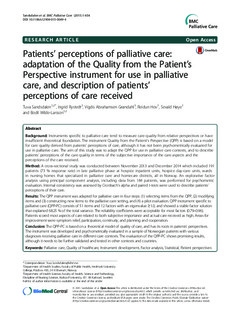| dc.contributor.author | Sandsdalen, Tuva | |
| dc.contributor.author | Rystedt, Ingrid | |
| dc.contributor.author | Grøndahl, Vigdis Abrahamsen | |
| dc.contributor.author | Hov, Reidun | |
| dc.contributor.author | Høye, Sevald | |
| dc.contributor.author | Larsson, Bodil Wilde | |
| dc.date.accessioned | 2017-11-20T13:36:04Z | |
| dc.date.available | 2017-11-20T13:36:04Z | |
| dc.date.created | 2015-11-09T14:26:46Z | |
| dc.date.issued | 2015 | |
| dc.identifier.citation | BMC Palliative Care. 2015, . | nb_NO |
| dc.identifier.issn | 1472-684X | |
| dc.identifier.uri | http://hdl.handle.net/11250/2467172 | |
| dc.description.abstract | Background: Instruments specific to palliative care tend to measure care quality from relative perspectives or have insufficient theoretical foundation. The instrument Quality from the Patient’s Perspective (QPP) is based on a model for care quality derived from patients’ perceptions of care, although it has not been psychometrically evaluated for use in palliative care. The aim of this study was to adapt the QPP for use in palliative care contexts, and to describe patients’ perceptions of the care quality in terms of the subjective importance of the care aspects and the perceptions of the care received. Method: A cross-sectional study was conducted between November 2013 and December 2014 which included 191 patients (73 % response rate) in late palliative phase at hospice inpatient units, hospice day-care units, wards in nursing homes that specialized in palliative care and homecare districts, all in Norway. An explorative factor analysis using principal component analysis, including data from 184 patients, was performed for psychometric evaluation. Internal consistency was assessed by Cronbach’s alpha and paired t-tests were used to describe patients’ perceptions of their care. Results: The QPP instrument was adapted for palliative care in four steps: (1) selecting items from the QPP, (2) modifying items and (3) constructing new items to the palliative care setting, and (4) a pilot evaluation. QPP instrument specific to palliative care (QPP-PC) consists of 51 items and 12 factors with an eigenvalue ≥1.0, and showed a stable factor solution that explained 68.25 % of the total variance. The reliability coefficients were acceptable for most factors (0.79–0.96). Patients scored most aspects of care related to both subjective importance and actual care received as high. Areas for improvement were symptom relief, participation, continuity, and planning and cooperation. Conclusion: The QPP-PC is based on a theoretical model of quality of care, and has its roots in patients’ perspectives. The instrument was developed and psychometrically evaluated in a sample of Norwegian patients with various diagnoses receiving palliative care in different care contexts. The evaluation of the QPP-PC shows promising results, although it needs to be further validated and tested in other contexts and countries | nb_NO |
| dc.language.iso | eng | nb_NO |
| dc.relation.uri | http://download.springer.com/static/pdf/460/art%253A10.1186%252Fs12904-015-0049-4.pdf?originUrl=http%3A%2F%2Flink.springer.com%2Farticle%2F10.1186%2Fs12904-015-0049-4&token2=exp=1447144607~acl=%2Fstat | |
| dc.title | Patients’ perceptions of palliative care: adaptation of the Quality from the Patient’s Perspective instrument for use in palliative care, and description of patients’ perceptions of care received | nb_NO |
| dc.type | Journal article | nb_NO |
| dc.type | Peer reviewed | nb_NO |
| dc.description.version | publishedVersion | nb_NO |
| dc.source.pagenumber | 14 | nb_NO |
| dc.source.journal | BMC Palliative Care | nb_NO |
| dc.identifier.doi | 10.1186/s1204-015-0049-4 | |
| dc.identifier.cristin | 1287413 | |
| cristin.unitcode | 224,40,0,0 | |
| cristin.unitname | Avdeling for helse og velferd | |
| cristin.ispublished | true | |
| cristin.fulltext | original | |
| cristin.qualitycode | 1 | |
